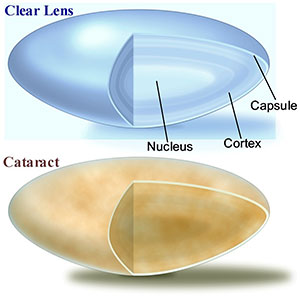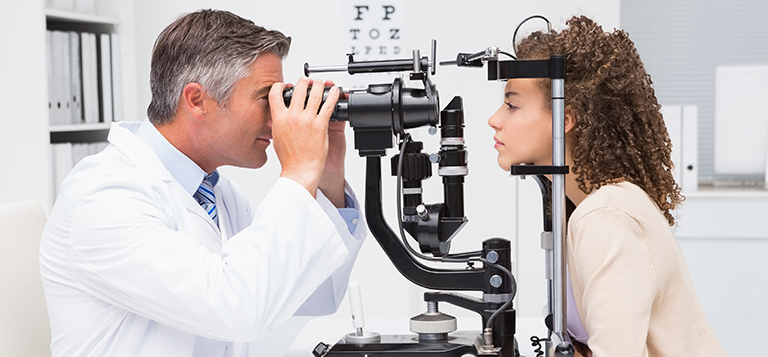Have you heard your friend tell you “My eye doctor told me I am getting a “Cadillac”?
Wouldn’t that be awesome? Imagine getting a Cadillac and cruising around town with it!
What your friend probably means is that the eye doctor is saying that you have “cataract.” Cataract is unfortunately something that we all will get if we live long enough. But fortunately, cataract surgery is a very common procedure and can help clear up your vision.
- What are cataracts? Cataracts occur when your natural lens in your eyes becomes more yellow and cloudy over time (see photo). Cataracts are very common in older people. The National Eye Institute1 reports that by the age 80, more than half of all Americans either have a cataract or have had cataract surgery.
- Cataract sign and symptoms: Cataract progresses unusually slowly and things start to become dim and cloudy. Some patients report that it feels like looking through a cloudy piece of glass. Colors start to seem faded. Night vision becomes more difficult
- Causes of cataract: Ultraviolet radiation from sunlight and other sources, Diabetes, Hypertension, Obesity, Smoking, Prolonged use of corticosteroid medications, Statin medicines used to reduce cholesterol, Previous eye injury or inflammation, Previous eye surgery, Hormone replacement therapy, Significant alcohol consumption, and Family history
- Cataract Prevention: Wearing protective sunglasses that contains 100% UV protection will help. Studies show that a good source of vitamin E included in sunflower seeds, almonds and spinach also helps. Good sources of lutein and zeaxanthin include spinach, kale and other green, leafy vegetables.2
- Cataract Treatment: When your cataracts have impaired your vision, surgery would be successful in restoring your vision. During surgery, the surgeon will remove your clouded lens and in most cases, replace it with a clear, plastic intraocular lens.

5 Myths about Cataract
- Eye drops can prevent or dissolve cataracts.
- Close-up tasks like reading or sewing make cataracts worse.
- Cataracts are reversible.
- Cataract surgery is dangerous, and recovery takes months.
- Cataracts “grow back.”

Dr. Pham-Vang is a MN board certified Optometrist. She earned a Fellowship from the American Academy of Optometry (FAAO). A FAAO is an optometrist who has been evaluated against the highest standards of professional competence and met rigorous qualifications for fellowship. Dr. Pham-Vang is dedicated and committed to providing the highest level of service and utmost quality of vision care for her patients. She currently practices in Champlin at a clinic called Sharp Vision located in the same complex as Cub Foods where she takes care of her patients’ complete eye care needs.
References
1“Facts About Cataract.” National Eye Institute, Sept. 2015,
https://nei.nih.gov/health/cataract/cataract_facts. Accessed 12 June 2017.
2Bailey, Gretchyn. “Cataracts.” All About Vision.com, http://www.allaboutvision.com/conditions/cataracts.htm. Accessed 12 June 2017.

